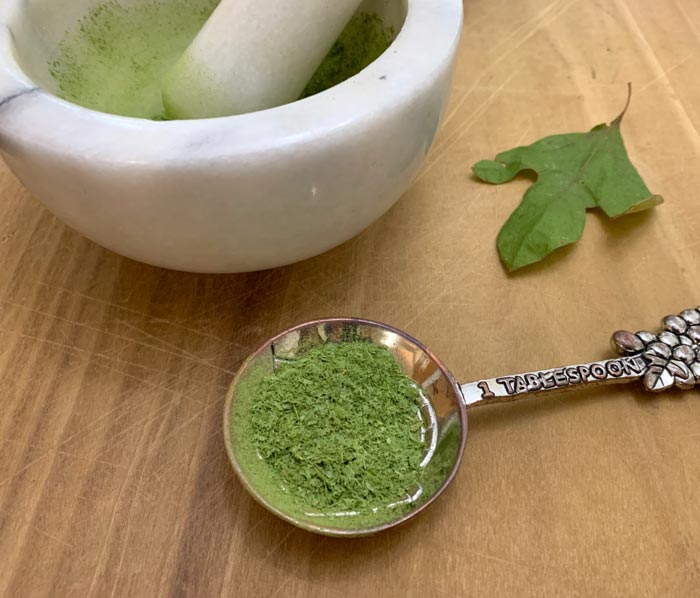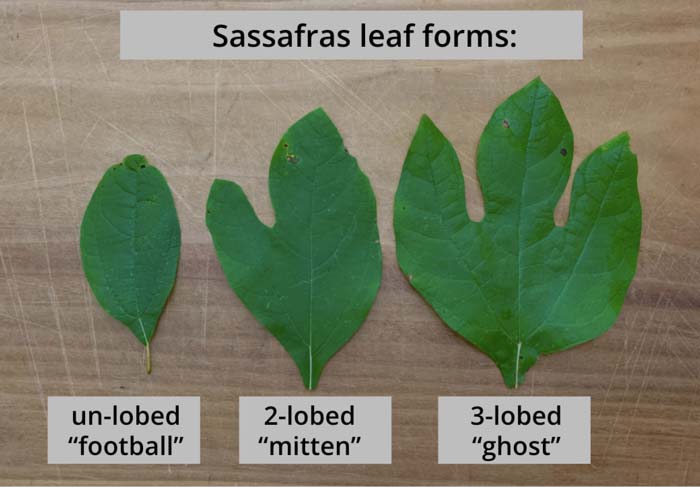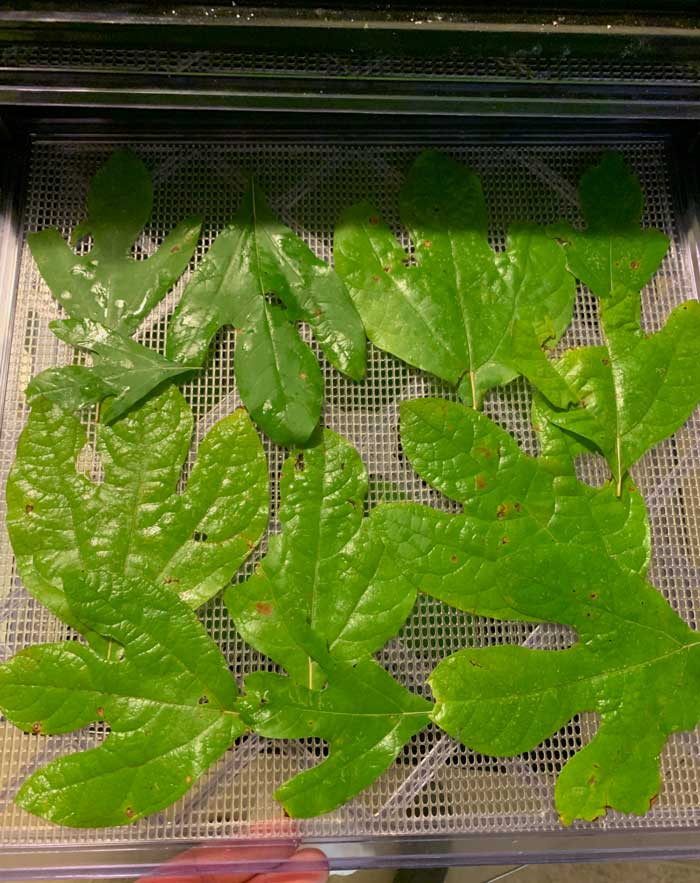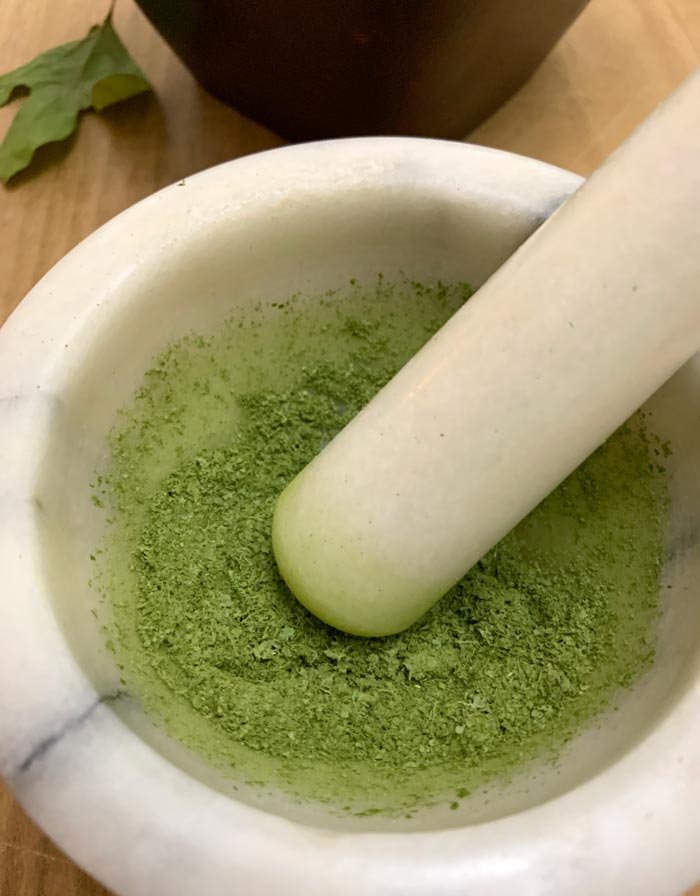Last Updated on October 31, 2021 by Aaron von Frank
Filé powder is a history-rich spice and thickener made from the dried, green leaves of sassafras trees. In this article, you’ll find out how to make your own filé powder and use it in the kitchen.
I’ll never forget my first taste of sassafras root tea, the red-colored, spicy concoction that tastes quite similar to the soft drink, Dr. Pepper. My mom taught my brother and I how to make the concoction using sassafras roots we dug during one of countless outdoor adventures in the Lowcountry of South Carolina.
The experience permanently etched sassafras trees (Sassafras albidum) into my brain as a special plant to be remembered. Had I grown up in Louisiana steeped in Creole and Cajun culture, I might have also grown up using the leaves of sassafras trees to make filé powder. That would have to come later…
Fast forward to today and my wife (The Tyrant) and I still live and forage in South Carolina, now in the Upstate. Sassafras is also abundant here so we’ve learned how to make filé powder from the leaves of the plant.
If you live in the eastern half of the United States, chances are you can make your own filé powder, too.

We hope you’ll use the information in this article to make your own homemade filé powder. Read on to find out how!
A brief history of filé powder
Everywhere sassafras grows, Native Americans used various parts of the tree for food and medicine, long before the arrival of Europeans.
Here’s a quick look at the native range of sassafras trees:
 If you live in the green areas of this map, you can find sassafras trees (Sassafras albidum) and make your own filé powder. (Public domain image credit: Elbert L. Little, Jr. // U.S. Geological Survey – Digital representation of “Atlas of United States Trees” by Elbert L. Little, Jr. Link)
If you live in the green areas of this map, you can find sassafras trees (Sassafras albidum) and make your own filé powder. (Public domain image credit: Elbert L. Little, Jr. // U.S. Geological Survey – Digital representation of “Atlas of United States Trees” by Elbert L. Little, Jr. Link)
What is now the US state of Louisiana started off as a French territory named in honor of the French King Louis XIV. The intermingling of Native American, African American, and French cultures led to fascinating culinary mashups. One of the best known creations: gumbo, a savory stew made with:
- meat (often sausage and seafood),
- vegetables (celery, bell peppers, onions), and
- a thickener.
The Choctaw people who were native to the region had long used ground sassafras leaves as a thickener in their cooking. African Americans had a tradition of using okra for the same purpose. And the French, of course, used roux (flour and butter mixture) as their thickener.
Even to this day, family recipes and chefs differ in opinion (often strongly) about exactly which combination of thickeners to use when making a “true” gumbo: filé powder, okra, roux, or various combinations thereof. No, we’re not taking sides because we know better.
Where does the word filé come from?
In French, filé means something like, “to become ropy or stringy.” This name alludes to the fact that if you put filé powder into a dish too early or try to store a dish with filé in it overnight, you’re likely to end up with a goopy mess instead of a silky smooth, thickened sauce.
That’s because sassafras leaves pack some serious mucilaginous properties – and you have to know when and how to add filé powder to a dish to get the right texture. (More on that later.)
How to make filé powder
Now let’s take a dive into how to make your own filé powder. Here’s a step-by-step:
Step 1. Identify sassafras trees near you.
First, you have to know what a sassafras tree looks like. Here’s how to identify a sassafras tree:
A. Sassafras leaf shape
Sassafras leaves are the single easiest way to ID the tree. The leaves are 4-8″ long and are one of the only tree species (along with red and white mulberry) that produce three distinct leaf forms on the same tree:
- three-lobed “ghost,”
- two-lobed “mitten,” and
- un-lobed “football” (that’s American football, you heathens).

The three common leaf forms of a sassafras tree. They can also occasionally produce 4- and 5-lobed leaves.
*Sassafras trees also occasionally produce four- and five-lobed leaves as well. (Thanks to our friend Ryan Merck for showing off a 5-lobed leaf he found.)
Sassafras leaves have rounded edges (no teether or sharp edges). Examine them closely and the top and bottom leaf surface have a slightly fuzzy texture. Crush a leaf or twig in your hand and you’ll note the distinctive sweet and spicy aroma of sassafras.
B. Sassafras tree size and growth habit
A mature sassafras tree can reach 60′ in height, but we’ve rarely seen them at this size. Typically, we find patches of young sassafras trees along forest edges that have formed small colonies via root suckers.
Each sassafras tree has a large central taproot and the lateral roots are what are harvested to make root beer/tea without killing the tree.
C. Sassafras bark/flowers/fruit
- Grey-brown ridged and craggy bark exterior on mature trees gives way to red interior color when bark is cut or damaged. Bark on young sassafras trees is smooth with a greenish-grey coloration.
- Sassafras trees produce attractive green/yellow flowers in the spring.
- Female sassafras trees produce gorgeous blue-black drupes (“sassafras berries”) attached to vibrant red stalks/pedicles. Flowers on female trees (if pollinated) give way to small pendant clusters of bluish-black berries (drupes) which are borne in scarlet cup-like receptacles on scarlet stalks (pedicels). Berries mature in late summer/early fall. No, sassafras berries are not edible to humans.
Are there any sassafras tree leaf lookalikes?
Red and white mulberry overlaps with much of the native range of sassafras and has vaguely similar looking leaves – even leaves with different shapes on the same tree, like sassafras. However, mulberry leaves are pointed with toothed-edges, whereas sassafras leaves are rounded with smooth edges.
Step 2. Sustainably harvest your sassafras leaves.
When should you harvest sassafras leaves for making into filé powder? Any time the tree has green leaves, you can harvest them for making into filé powder.
Notice we said leaves, not branches. Some people advise cutting off entire branches from the tree when making filé powder. This practice can injure or kill a young sassafras tree. Instead, we’d advise the following to sustainably harvest sassafras leaves:
- Harvest leaves only by pinching or cutting them off the tree, NOT by removing entire branches.
- Only harvest lower leaves and no more than 25% of the total leaves on the plant IF you’re harvesting in spring or summer.
- You can harvest leaves much more aggressively in early fall when the leaves are still green right before they begin to turn color. (This is when/how we prefer to harvest sassafras leaves.)
View this post on Instagram
Step 3. Dry your sassafras leaves.
You want sassafras leaves to be green but crunchy dry before processing them into filé powder. We use a 9-tray Excalibur dehydrator turned to ~100°F (38°C) overnight to dry our leaves.

We use an Excalibur dehydrator to dry our sassafras leaves quickly (about 12 hours). However, you can just let your leaves dry indoors for about a week instead of using a dehydrator.
However, you don’t have to have a dehydrator or any fancy equipment to dry sassafras leaves. You can simply put them in a single layer in a dry indoor location for a week or so.
*One thing you’ll want to do either before or after you dry the leaves is remove the stems, which are too woody to grind into powder. You can do this fairly quickly by hand or with a knife. If you do it after the leaves are dried, you can simply crunch (with very dry hands) the leafy material into a large bowl, then compost the woody stems left in your hand.
4. Powder your sassafras leaves into filé powder.
How fine do you want your filé powder to be? A high quality commercial filé powder is just that: a powder. This was traditionally done with a large mortar and pestle.
With our existing home equipment, we first put our leaves through a multi-blade Ninja. Then we take the finely shredded leaves and grind them in a mortar and pestle.

Final steps: grinding the dried chopped sassafras leaves into filé powder with a mortar and pestle.
A powder consistency will provide a better spice/thickener, but you could consider your filé done after running your dried leaves through a multi-bladed blender or food processor.
5. Store your filé powder in airtight spice jars.
Finally, transfer your finished filé powder to labeled spice jars (with name of spice + date processed). For larger quantities, ziplock bags or large canning jars will work fine too.

Homemade filé powder in a spice jar.
How long does filé powder last? Filé powder stored in an airtight jar in your cupboard should maintain its distinctive flavor and green color for about 6 months before oxidation begins to make it more brown-colored in appearance.
Now you know how to make your own filé powder! Next comes the best part: using it to season and thicken delicious, history-rich recipes. Enjoy!
Frequently asked questions about filé powder
How do you pronounce filé?
Filé is pronounced “fee-lay.”
What does filé powder taste like?
Filé powder has complex flavor notes: mild root beer, earthy-grassy, and a touch of bitter. Like most herbs, filé powder isn’t something you want to eat by the spoonful, but it ads wonderful flavor nuance to dishes in addition to being a thickening agent.
Why does filé powder thicken sauces and have mucilaginous properties?
Virtually every plant produces mucilage to varying degrees to help with water and nutrient storage, among other factors. On the far side of the high-mucilage spectrum are plants like prickly pear cacti.
Sassafras leaves happen to contain relatively high quantities of mucilage, which then thickens whatever filé powder is added to.
Are there any filé powder substitutes?
Okra is the most common substitute for filé powder since okra pods are also highly mucilaginous. Some gumbo recipes even use both okra and filé powder, although others prefer one versus the other.
Before the days of freezers, it’s quite possible that okra was used to thicken gumbos and jambalayas in the summer when it was in season, while filé powder would be used in cool seasons.
Another possible filé powder substitute that we love is Malabar spinach, which we use to make maafe/African groundnut stew. Malabar spinach tastes like spinach but is highly mucilaginous. It doesn’t pack the unique spicy punch of filé powder, however.
Can you use filé and okra or other thickeners at the same time?
The answer to this question depends on which chef you ask – or which family recipe you use. If using both filé powder and okra in the same dish, be mindful that it’s very easy to over-thicken things, especially if there’s a roux in the mix.
Do you have to refrigerate filé powder?
No, you don’t have to refrigerate filé powder, but doing so will extend its life by many months (both color and flavor).
When should you add filé powder to a meal, like gumbo or jambalaya?
General advice:
- If you’re not likely to have leftovers, add filé powder to the pot AFTER you’ve taken if off the heat and right before serving.
- If there’s likely to be leftovers, either: a) add filé powder when plating, or b) let folks add their own filé powder to their desired taste/consistency.
Adding filé powder too soon can lead to a thick, stringy sauce. Same thing happens if you re-heat a sauce with filé powder already in it.
What else can you use filé powder on?
Any sauce, soup, or gravy that needs a pleasantly spiced thickener can benefit from the addition of filé powder. Get to know it a bit and use your imagination.
Are filé powder or sassafras leaves carcinogenic (cancer-causing)?
Oil in the roots and bark of sassafras contain safrole, a compound also found in many other edible plants such as basil, black pepper, cinnamon, nutmeg, and others. In the 1960s, scientists gave high concentrations of safrole to lab mice, which then developed high rates of cancer. Thus, safrole oil (and sassafras roots/bark) were banned for human consumption in the United States.
More recent research has cast doubt on the potential for safrole and/or sassafras root and bark products to have potential carcinogenic effects on humans because humans aren’t mice and we metabolize these compounds much differently.
Regardless, sassafras leaves and filé powder are NOT potentially carcinogenic because they contain virtually no measurable quantities of safrole, unlike the roots and bark.
Are there good store-bought filé powders?
If you don’t want to or can’t make your own filé powder, we’d recommend you get Zatarain’s file powder.
KIGI,

Spice up your life with other edible native perennial plants:
- How to make acorn flour (cold- or hot-leached)
- Recipe: Hickory nut ambrosia
- American vs Asian persimmons: growing, foraging, eating
- How to use American beautyberry as food and mosquito repellent
- Aronia melanocarpa: how to grow or forage the world’s highest antioxidant fruit
- Common milkweed: how to eat your Monarch butterfly garden
- Yaupon holy: grow your own native caffeine
- Native passionfruit: how to find, id, grow, and eat
- How to grow pawpaw trees
- How to grow American groundnuts in your garden
Like what you're seeing here? Please be sure to subscribe to Tyrant Farms so we can let you know about new articles you'll love.



4 Comments
Morris Soudelier
May 7, 2025 at 1:36 pmthank you so very helpful
Susan von Frank
May 8, 2025 at 12:12 pmYou’re very welcome, Morris! Good luck making your own filé powder.
Karen
September 27, 2022 at 5:59 amGreat informative article, thank you!
Aaron von Frank
September 27, 2022 at 8:32 amGlad it was helpful, thanks Karen! Hope you’re able to make your own filé powder.